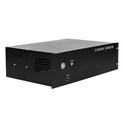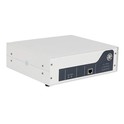As a supplier of ultrasonic vibration tables, I often receive inquiries about the power requirements for these innovative pieces of equipment. Understanding these requirements is crucial for ensuring optimal performance, efficiency, and longevity of the ultrasonic vibration tables. In this blog post, I'll delve into the factors that influence the power needs of ultrasonic vibration tables and provide insights to help you make informed decisions.
Basics of Ultrasonic Vibration Tables
Ultrasonic vibration tables are designed to generate high - frequency vibrations in the ultrasonic range, typically between 20 kHz and 40 kHz. These vibrations are used in a variety of applications, including material processing, cleaning, and testing. The vibrations can enhance processes by reducing friction, improving material flow, and increasing the efficiency of chemical reactions.
Factors Affecting Power Requirements
Table Size and Dimensions
The physical size of the ultrasonic vibration table is one of the primary factors influencing its power requirements. Larger tables generally need more power to generate uniform vibrations across the entire surface. For example, a small - scale table used for precision parts cleaning may require only a few hundred watts, while a large industrial - grade table designed for bulk material processing could need several kilowatts of power.


Load Capacity
The amount of weight the table needs to support also impacts power consumption. A table with a high load capacity must have sufficient power to vibrate the load effectively. When dealing with heavy or dense materials, more energy is required to overcome the inertia of the load and maintain the desired vibration amplitude. For instance, if you are using an ultrasonic vibration table to compact heavy metal powders, the power demand will be significantly higher compared to vibrating a lightweight plastic component.
Vibration Frequency and Amplitude
The frequency and amplitude of the ultrasonic vibrations are critical parameters that affect power requirements. Higher frequencies generally require more power to generate. For example, a table operating at 40 kHz will typically consume more power than one operating at 20 kHz, assuming all other factors are equal. Similarly, increasing the amplitude of the vibrations, which is the maximum displacement of the vibrating surface from its equilibrium position, also demands more power. This is because greater amplitude means more energy is needed to move the table surface and the load over a larger distance.
Application Requirements
Different applications have unique power needs. In cleaning applications, the power is used to create cavitation bubbles in the cleaning solution, which helps remove contaminants from the parts. The power required depends on the type and amount of dirt, the size of the parts, and the cleaning solution used. In material processing applications, such as ultrasonic welding or forming, the power is used to soften or deform the material. The power demand will vary based on the material properties, such as its hardness, melting point, and viscosity.
Power Requirements of Our Product Lines
We offer a range of ultrasonic vibration tables, each with specific power requirements tailored to different applications.
The ResoTab - F20 Ultrasonic Vibration Tables are designed for medium - sized applications. These tables typically require a power input in the range of 500 watts to 1500 watts, depending on the specific configuration and the load. They are suitable for applications such as precision parts cleaning, small - scale material mixing, and light - duty ultrasonic testing.
The ResoTab - F20A Ultrasonic Vibration Tables are an upgraded version with enhanced performance. They can handle slightly higher loads and more demanding applications. The power requirements for these tables range from 1000 watts to 2500 watts. They are ideal for applications like ultrasonic soldering, medium - sized component assembly, and some types of material forming.
The ResoTab - P30 Ultrasonic Vibration Tables are our heavy - duty models. These tables are built for large - scale industrial applications, such as bulk material compaction, large - part cleaning, and high - volume ultrasonic welding. The power consumption of the ResoTab - P30 can be as high as 5000 watts or more, depending on the specific operating conditions.
Energy Efficiency Considerations
When choosing an ultrasonic vibration table, it's important to consider energy efficiency. A more energy - efficient table can reduce operating costs over the long term. We design our tables with energy - saving features, such as advanced control systems that optimize power consumption based on the load and the application requirements. These systems can adjust the power output in real - time, ensuring that the table uses only the amount of power necessary to achieve the desired results.
Power Supply and Safety
Proper power supply is essential for the safe and reliable operation of ultrasonic vibration tables. Our tables are designed to operate within a specific voltage and frequency range. It's important to ensure that the power supply meets these requirements. Additionally, we incorporate safety features such as over - current protection, over - temperature protection, and short - circuit protection to prevent damage to the table and ensure operator safety.
Making the Right Choice
When selecting an ultrasonic vibration table, it's crucial to accurately assess your power requirements. Consider the size of the parts or materials you'll be working with, the type of application, and the desired vibration frequency and amplitude. Our team of experts can help you determine the most suitable table for your needs and provide detailed information about its power requirements.
If you're in the market for an ultrasonic vibration table, we encourage you to reach out to us for more information. We can offer customized solutions based on your specific requirements and help you optimize your processes. Whether you're a small - scale manufacturer or a large industrial enterprise, we have the right table for you. Contact us to start a discussion about your ultrasonic vibration table needs and explore the possibilities of enhancing your operations with our high - quality products.
References
- "Ultrasonic Technology in Manufacturing Processes" - A comprehensive textbook on the principles and applications of ultrasonic technology in manufacturing.
- Industry reports on the development and usage of ultrasonic vibration tables in different sectors.
- Technical specifications and research papers provided by ultrasonic equipment manufacturers.






